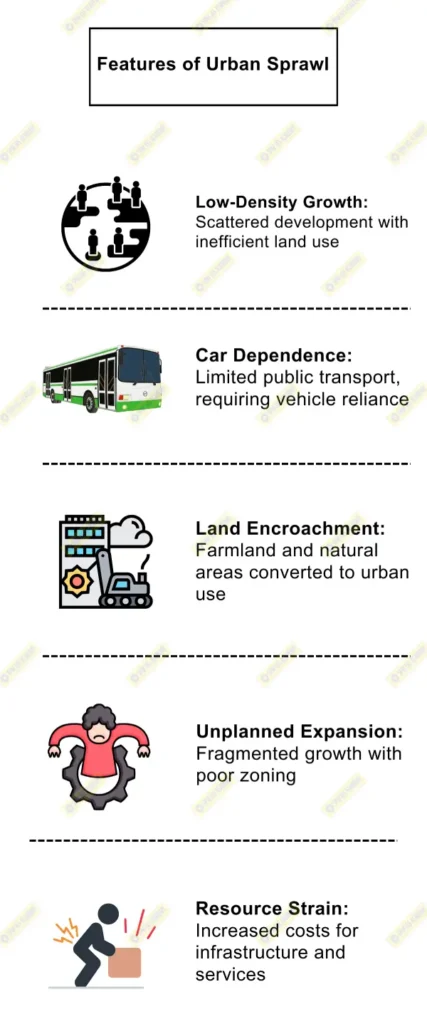Urban sprawl refers to the unplanned and excessive expansion of cities into surrounding rural or semi-urban areas, characterized by low-density development and inefficient land use. It is driven by rapid urbanization, economic growth, and weak urban planning. In India, cities like Guwahati are experiencing significant urban sprawl, which poses challenges to sustainability. According to the World Bank (2021), urban areas in India are projected to house over 600 million people by 2036, highlighting the urgency for sustainable urban management.
Factors Promoting Urban Sprawl
- Population Growth
○ Growing urban populations create demand for housing and infrastructure, leading to expansion into peri-urban areas.
○ For instance, Guwahati’s population surged by over 38% between 2001 and 2011 (Census 2011), resulting in residential growth in areas like Jalukbari and Basistha. - Economic Development
○ Industrial and commercial growth attracts migration and fosters the outward expansion of cities.
○ Guwahati’s Amingaon industrial zone and proposed IT parks have significantly influenced urban spread into suburban areas. - Improved Connectivity
○ Enhanced transportation networks, such as highways and metro systems, enable easier access to peripheral regions.
○ The proposed Guwahati metro project and four-lane highways have accelerated suburban development in areas like Lokhra and Narengi. - Housing Demand and Affordability
○ Rising land and property costs in urban cores push middle-income and low-income groups to the outskirts.
○ Pradhan Mantri Awas Yojana (PMAY) promotes affordable housing in peripheral zones, driving sprawl. - Weak Urban Planning
○ Inadequate enforcement of master plans and zoning laws results in haphazard development.
○ For instance, Guwahati’s city development plan has not fully addressed land-use management, leading to unregulated expansion. - Migration and Urbanization
○ Influx of rural migrants increases urban demand, forcing cities to grow outward.
○ Guwahati attracts significant migration from rural Assam and neighboring northeastern states due to employment and educational opportunities.
Environmental Impacts of Urban Sprawl
- Loss of Agricultural and Forest Land
○ Conversion of fertile lands into urban spaces reduces agricultural output and disrupts ecosystems.
○ In Guwahati, peri-urban areas like Sonapur and Rani have witnessed deforestation and loss of agricultural fields to real estate projects. - Increased Air and Water Pollution
○ Sprawl leads to vehicular emissions and untreated industrial discharge, degrading air and water quality.
○ Pollution from suburban industries and urban runoff affects the Brahmaputra River and its tributaries. - Decreased Biodiversity
○ Habitat destruction for urban expansion threatens wildlife and reduces biodiversity.
○ Deepor Beel, a Ramsar site in Guwahati, faces encroachments, leading to a decline in aquatic and avian species. - Higher Carbon Footprint
○ Dependency on private vehicles due to poor public transport infrastructure increases greenhouse gas emissions.
○ Suburban residents in Guwahati rely heavily on personal cars and motorcycles, contributing to a higher carbon footprint. - Urban Flooding
○ Encroachment on wetlands and poor drainage systems exacerbate flooding in cities.
○ Unregulated development around Silsako Beel in Guwahati has worsened monsoon flooding in adjoining areas.
Socio-Economic Impacts of Urban Sprawl
- Infrastructure Strain
○ Peripheral areas often lack basic amenities like water, sanitation, and healthcare, creating inequalities.
○ In suburban Guwahati, regions like Satgaon face inadequate municipal services despite population growth. - Social Segregation
○ Sprawl often creates gated communities for the affluent while low-income groups reside in unplanned settlements, deepening social divides.
○ Guwahati’s outskirts house upscale colonies in Narengi, while informal settlements grow along the riverbanks. - Economic Inefficiency
○ Extending infrastructure to far-flung areas increases costs for the government, diverting resources from other priorities.
○ The expansion of roads and power grids to Guwahati’s outskirts has strained the city’s budget. - Increased Commuting Time
○ Longer distances between suburbs and city centers lead to traffic congestion and reduced productivity.
○ Guwahati’s commuters from areas like Lokhra spend hours navigating traffic to reach workplaces in the core city. - Decline of Urban Cores
○ As people and businesses move to suburban areas, city centers experience urban decay and reduced economic activity.
○ Guwahati’s central commercial hubs, like Paltan Bazar, face reduced footfall due to suburban retail development.
Example: Urban Sprawl in Guwahati
- Expansion Areas: Jalukbari, Basistha, Lokhra, and Narengi have witnessed rapid suburbanization with minimal regulation.
- Environmental Impact: Encroachments on wetlands like Deepor Beel have exacerbated flooding, while suburban industries pollute water bodies.
- Socio-Economic Impact: Peripheral areas struggle with inadequate public transport and civic infrastructure, while the city core faces declining economic activity.
Committee Reports and Recommendations
- National Urban Transport Policy (2006)
Recommends compact cities and transit-oriented development to curb sprawl. - High-Powered Expert Committee (2011)
Highlights the need for integrated urban planning to optimize infrastructure investments and control unregulated expansion. - State Innovation and Transformation Aayog (SITA)
Advocates urban-rural integration and sustainable planning to reduce migration pressures on Guwahati.
Urban sprawl reflects the challenges of unregulated growth and weak governance. While it fosters economic opportunities and housing, its environmental and socio-economic costs necessitate immediate intervention. Adopting smart urban planning, protecting natural ecosystems, and implementing robust zoning laws are crucial for mitigating sprawl. Guwahati must prioritize sustainable development to balance growth with environmental conservation, ensuring resilience for future generations.












